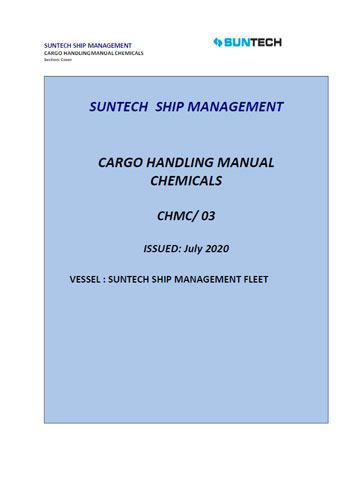Cargo Handling Manual Chemicals/Химикаты для ручной обработки грузов
Издание на английском языке
This manual is for use on Suntech Ship Management Vessels.
Table of contents
Introduction
1 Responsibilities
1.1 General
1.2 Master
1.3 Chief officer
1.4 Second officer and third officer
1.5 Chief engineer
1.6 Pumpman
1.7 Bosun/ ratings
2 Definitions, equipment & design
2.1 Definitions
2.2 Ship types
2.3 Cargo types
2.4 Piping, pumping & tank arrangements
2.5 Gauging systems
2.6 Level alarms and overflow control system
2.7 Cargo tank venting and vapor return
2.8 Accomodation vent airlocks
2.9 Type of cargo pumps
2.10 Tank temprature control
2.11 Cargo tank pressure sensors
2.12 Safety factors for electrical systems
2.13 Emergency towing arrangement and fire wires
2.14 Prevention of sweat in cargo tank
2.15 Stren loading and discharge arrangements
2.16 Abbreviations
3 Safety
3.1 Chemical hazards
3.2 Physical properties of chemicals
3.3 General precautions
3.4 Removable bends, spool pieces and flexible hoses
3.5 Flame arrestors
3.6 Electrical equipment/fittings
3.7 Hydrocarbon and toxic gas monitoring
3.8 Void spaces/duct keels and pipe tunnels
3.9 Leakage into void and ballast spaces
3.10 Works in cargo and ballast tanks
3.11 Accidental spillages
3.12 Chemical tanker explosions
3.13 Cargo pumprooms
3.14 Inhibited cargoes
3.15 Procedure for entering cargo tanks for squeezing/puddling
3.16 MSDS and the procedure to obtain the same
3.17 Revizied minimum safety standards for ships carrying liquids in bulk containing benzene (MSC/ CIRC.1095)
Departure from procedures within the SMS (management of change)
4 Cargo handling
4.1 General
4.2 Voyage planning & stowage of cargo
4.3 Slop handling on chemical tankers
4.4 Vapour emission control (VEC) Systems
4.5 Ship-to-ship (STS) transfer using VEC systems
4.6 Segregation of cargoes
4.7 Cargo samples
4.8 Portable cargo pump
4.9 Leakage of chemicals into adjacent double hull spaces
4.10 Adding substances to the cargo
4.11 Heating
4.12 Agitation/ re-circulation
4.13 Efficient stripping as per P&A manual
4.14 Explanation of cargo compatibility chart
4.15 Care and handling of cargo hose
4.16 Cargo contingency plans
4.17 Shore line flush
4.18 Ballasting cargo tanks and ballast tanks for inspections/surveys
5 Cargo transfer
5.1 General
5.2 Cargo loading
5.3 Precautions during the voyage
5.4 internal transfer
5.5 Discharging
5.6 Handling of multiple grades/ multiple operations simultaneously
5.7 Cargo measurement
5.8 Ballast operations
5.9 Reporting of defects & deficiency
6 Nitrogen operations, inerting and gas freeing
6.0 Nitrogen handling
6.1 Inerting/purging
6.2 Padding
6.3 Line blowing/pigging
6.4 Pressure loading
6.5 Receiving nitrogen from liquid source ashore
6.6 Failure of N2 supply or N2 plant
6.7 Inert gas system and inerting
6.8 Gas freeing and venting
6.9 Vapour tightness
7 Cargoes requiring special precautions
7.1 High vapour pressure cargoes
7.2 Static generating cargoes
7.3 Aromatic cargoes
7.4 Ploymerizing cargoes
7.5 Solidifying cargoes
7.6 Toxic cargoes
7.7 Corrosive cargoes
7.8 High viscosity cargoes
7.9 Oxygen depleting / displacing substances
7.10 High density chemical cargo
8 Tank cleaning & tank preparation
8.1 General
8.2 Tank preparation
8.3 Tankcleaning principles
8.4 Tankcleaning procedures
9 Static electricity
9.1 Principles of electrostatics
9.2 General precautions against electrostatic hazards
9.3 Other sources of electrostatic hazards
10 Passivation/ pickling, coatings and stainless steel
10.1 Application of stainless steel on board the vessel
10.2 Corrosion of stainless steel in sea water
10.3 Corrosion resistance of austenitic stainless steels
10.4 Welding
10.5 Repair and maintenance of cargo tanks and coatings
10.6 Pickling and passivation
10.7 Steel and phosphoric acid
Appendix 1 Ops forms
Appendix 2 PPE matrix (in company’s ERP mariner)
Appendix 3 Special cargoes
Caustic soda
Hydrocracker bottom (HCB)
Mono ethylene glycol (MEG)
Phenol
Styrene monomer
The vegetable oil
Benzene
Caradol
Acrylonitrile




